Originally posted May 3, 2013:
Diana Lucas entered the Electric Foreman’s office one morning at the Coal-fired Power Plant almost in a rage! I didn’t understand why at first, and I also couldn’t quite tell if she was really in a rage, or if she was just excited about something, because she seemed to be both at once. Which I guess is the case when one is in a rage, but there seemed to be a tint of amusement in her rage which was the cause of my confusion.
Bill Bennett our A Foreman had come to the shop a little earlier than usual that morning and was apparently waiting for Diane’s entrance, foreseeing her reaction. Bill had hopped up out of his chair and immediately tried to explain to Diane (yeah, her name was Diana, but most called her Diane. Well, actually, most everyone called her Dee). Diana Brien (as she was later named) seemed a little more musical than Diane Brien. Maybe it is just the Italian in me that likes to put vowels on the end of names.
Anyway, Diane was saying something like, she couldn’t believe that Bill had actually hired some particular person as a contract worker for our shop. Bill responded to her by pointing out that he would be working for her this time. If she wanted, she could have this guy doing the dirtiest and rottenest (rottenest? really? Is that a real word?) jobs. This seemed to calm her down a little and the two of them walked out into the shop.
Charles Foster, one of the electrical foremen, and my closest friend turned to me and explained that Diana and some others in the shop (Ben Davis, and I think and even Andy Tubbs) had worked for this guy when they were working for Brown and Root building the plant. He was a supervisor that was disliked by most of the people that worked for him because, well, according to Diana, he was some kind of slave driver.
Ok. When I finally understood the rage emanating from the Lady ‘lectrician, I decided I would amble out into the shop to prepare for my day performing feats of electrical magic. I also figured I would take a gander at the new figure of the old man leaning against the workbench to see the center of the conflict and to stare it in the face. I figured if I had a good close look at him, I would be able to see inside his character. I already disliked him before I walked out of the office after hearing how he had treated my mentors.
I know my memory of my first encounter with Bill Boyd is not what really happened, because in my mind I have embellished it and have rewritten it in order to include thoughts that came from deep within me. So, even though I probably walked out into the shop and glanced over at this old codger standing there, picked up my tool bucket and walked out the door, I remember it quite differently….. This is how remember that moment (the one that really didn’t happen….. well, not exactly)….
In my mind I remember walking into the shop and noticing this tall lanky older man hunched over birdlike, almost like a raven, as his nose reminded me of a beak. A cranky looking man. He looked tired. Worn out. Like it was a struggle for him to take each breath. I thought, “Ok. This raven has come home to roost. Only he doesn’t know what hornets nest he has just stepped into.”
Sure enough. Bill Boyd was given one distasteful job after another. At least, I think that was the intention. He was tasked to sweep out the main switchgear and the other switchgears around the plant. Anything that was repetitive and boring. He worked away at his tasks without complaint. Slowly and steadily.
I noticed that Bill Boyd was taking a lot of pride in his work no matter how menial the task was. He was very meticulous. A couple of years later when he came back to work for us again, he was working for me. And at that time I had him cleaning out both of the Precipitator control cabinet rooms.
Not only did he clean the rooms to where you could eat on the floor, but he also opened each of the cabinets and vacuumed them out, and changed every one of the 4 inch square filters (2 in each of the 84 cabinets in each of the two rooms — for a total of 336) filters by cutting them out of sheets of blue and white filter material using a large pair of scissors.
Bill Boyd liked to tell stories about different jobs he had throughout his career. He had worked in various places around the world. He had held all types of jobs. I think he helped build most of the important monuments that exist in the world today. At least that might be the impression you might have by listening to him tell his stories. I couldn’t disagree with him too much. After all, he was working at the most monumental Power Plant of all time right then. If he was lucky enough to do that, then I suspect that most of what he was saying was true.
One day just at the end of the day when it was time to leave for the day, I walked out of the electric office into the shop and headed for the door. Just as I passed Bill Boyd, he said rather forceably to Andy Tubbs, “What did you say?” Andy said something back to him, and glancing back I saw that Bill had a surprised and confused look on his face.
So, as we were walking to the parking lot I asked Andy what he had said. Andy said that he told Bill that his stories couldn’t be true. Bill had asked him why he thought that. Andy had replied, “Because if you did all the things you say you did, you would have to be 200 years old!” I laughed at that. I thought…. well…. he probably is.
So, Now that I have introduced you to Bill Boyd, here is the more interesting parts of the story of Bill Boyd’s tenure at the Power Plant Palace. I have three small stories that I still often think about:
The first one is rather short, so I’ll start there…. I walked into the electric shop office one morning before it was time to begin my work day and sat in a chair. Bill Boyd was already there sitting across the room from me, silently meditating….. well…. he might have been mildly snoring…. I don’t remember exactly. Anyway. There was just the two of us in the room.
I suddenly noticed that there was a strange ticking sound. A very definite tick tick tick, like a pocket watch, only a little louder. I rose from my chair and looked around the room trying to figure out what was ticking…. It’s strange to think about it, because right outside the east wall (no. actually the north wall… I just always had my directions turned 90 degrees) of the office was the roaring steam pipes shooting high pressure steam into the turbines, creating the electricity that lit up the state of Oklahoma.
Even amid the roar of the steam pipes, I could hear this ticking. I approached Bill, and sure enough. Bill was ticking. Looking at his trousers, and his shirt pocket, I didn’t see anything that looked like a chain that may have a pocket watch connected.
The thought of a time bomb went through my head. I also had thoughts of being late for an important date, and thoughts of lunch, among other things…..
So, I returned to my seat, then I hollered out to him, “Bill!” He stirred from his sleep, um… I mean, his morning meditation…. I continued, “Bill, you are ticking!” Looking confused, he said, “What?” I replied, “You are ticking.” Bill asked, “You can hear that?” I assured him I could. He said, “Well, that’s my ticker. My pacemaker.”
Whoa. I was listening to his pacemaker from across the room! Crazy! So, after that I would hear his pacemaker all the time he was around. I guess once I had tuned into the frequency, I couldn’t get it out of my head…. I sort of had it in the back of my head that I hoped that I didn’t hear it miss a beat…. I never did… it just kept on ticking.
The next story has to do with finding a buried cable. Bill Bennett brought this specialized cable finder down to the shop one day and told us that we had to mark an underground cable that went from the main substation up to the front gate to a transformer. Someone was going to be doing some digging in the area and they wanted to make sure they didn’t cut into this cable because it was the main station power to the substation relay house.
This cable finder had one piece that you placed on the ground above where you knew the cable was buried, and then you walked along with a sensor picking up the signal from the cable.
I was all excited to go try out our new fangled cable finder. Unfortunately, we were trying to find a cable underneath some very high voltage lines leaving the substation, which rendered the sophisticated cable finder completely useless. There was too much electrical interference from our surroundings.
So, after trying to find the cable all day without success, and upon returning to the shop disillusioned with our new toy, Bill Boyd said, “I can help you find the cable.” As we wondered what he meant, he repeated, “I can find the cable for you.”
I don’t remember if it was Andy, or if I asked him just how he was going to do that. Bill replied, “By using a divining rod.” Huh? A divining rod? Yep. He was serious. The next day he came to work with two metal rods about 2 1/2 feet long, bent at one end so that you could hold them and they would point straight out in front of you.
So, I drove him over to the substation and Bill tried to use the divining rods to find the cable. He paced back and forth holding the rods up by his face, with his shoulders hunched over like a vulture… or was it a raven? After pacing back and forth for about 20 minutes he returned to the truck and said he couldn’t find the cable because the wind was blowing too hard.
The wind in Oklahoma generally begins blowing about 8 o’clock in the morning during the summer, and doesn’t let up until…. well… until… maybe the end of the summer, if you’re lucky. So, we went back to the shop. Bill Bennett was waiting to see if he was successful. Leroy Godfrey had bet that he would find the cable. We said it was too windy.
The next morning when we were driving to work, I looked out in the field by the substation and there was Bill Boyd all by himself walking slowly along with the two metal rods sticking straight out from his face.
When I arrived at the shop, I jumped in the truck and headed out to the field. Bill said that he found the cable. It wasn’t where we originally thought. It was about 25 yards over from there. He showed me that as he walked over a certain spot that his rods moved from being straight out, to swing out to the side. When he held the two rods farther apart, when he walked over the same spot, the rods came together. Bill said. The point where they cross is where the cable. is.
Ok. I wasn’t really buying this. I guess it must have showed on my face, or maybe I actually let out a snicker….. I’m not sure… I suppose it was the look of disbelieve, because I’m not prone to snicker, even when confronted with total insanity. So, Bill turned and handed the rods to me and said, “Try it.”
So I took the two rods in my hands:
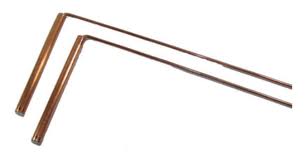
A similar pair of divining rods. These are a lot shorter than the ones we used. Maybe they just go off the end of the picture
I slowly walked forward with the two rods sticking out in front of me. As I approached the spot where he had indicated the cable was buried the two rods parted until they became parallel with each other. The left one pointing left, the right pointing right. No Way! I backed up, and as I did the rods came back together. I moved forward again and they went apart! I could hear the mild excited chuckling behind me.
We took a can of orange spray paint and made a mark on the ground. then we moved about 20 feet away from that mark and did it again. Sure enough… there it was again. We marked the ground every 20 feet all the way up to the main gate. And get this. It even worked where the cable was buried under the railroad tracks. I walked down the middle of the railroad track and could tell right where the cable was buried underneath it.
So, after that, I kept my own pair of divining rods in my garage. Bill explained that you could bury a new pipe under the ground and you would not be able to find it, but after something runs through it, like water or electricity or even a wad of rags, you can find it using the divining rods.
One day a few years later, my brother was visiting my house when I lived out in the country and he brought up someone who claimed to use a divining rod to find something, and I told him that I had a divining rod and you can use it to find cables and sewer lines and water pipes with it. — Of course, he had the same reaction I did, so we went out in the front yard and I told him how to hold them, and let him find out for himself. It only takes once. The result is so noticeable, it doesn’t leave any question in your mind when it happens.
Ok. The last story….
It turned out that over the years as Bill Boyd would come to the plant as a contract worker, we came to be friends. One day he invited me to his daughter’s recital at Oklahoma State University where she was playing the Cello in a chamber orchestra. I was honored to be invited by him and my wife and I joined Bill and his wife as we listened to his daughter play. One day he told me the story of when he was working in Germany in 1959 and he bought a Cornelius Ryan novel called The Longest Day. After listening to his story, he told me that he wanted me to have the book.
The next day, he showed up to work with three books. The first book was from 1959. The next one was 1966, and the third one was 1974. But you could tell they were all a set, and by the way that Bill Boyd held them, they were important to him. So I accepted his gift with thanks.
I have kept books with care since the day that I received them, as I have kept my memory of Bill Boyd. A true Power Plant Raven.
Comment from the original Post:
As a summer student at the Mustang Plant in 1967 I was a skeptic about the use of diving rods. In the “Results” office one of the Instrument Technicians showed me how they could locate pipes under the floor. I can’t remember which technician showed me this (Bud Gray, Leldon Blue, Montie Adams, or Kenneth Palmer), but I tried them myself – and they worked! I’ll never forget my surprise.
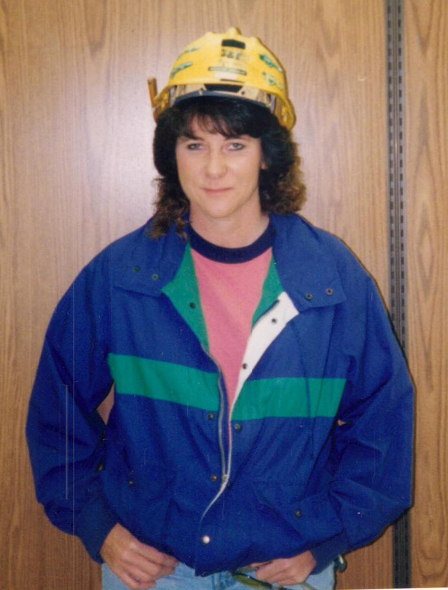


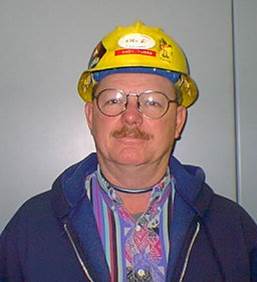
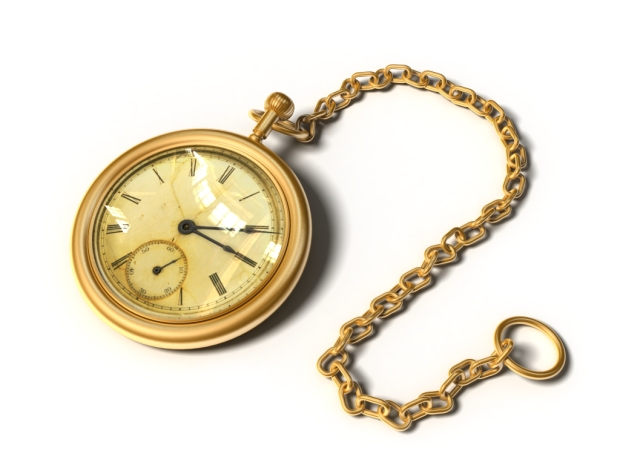
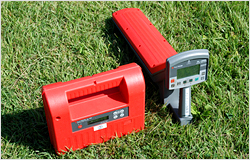
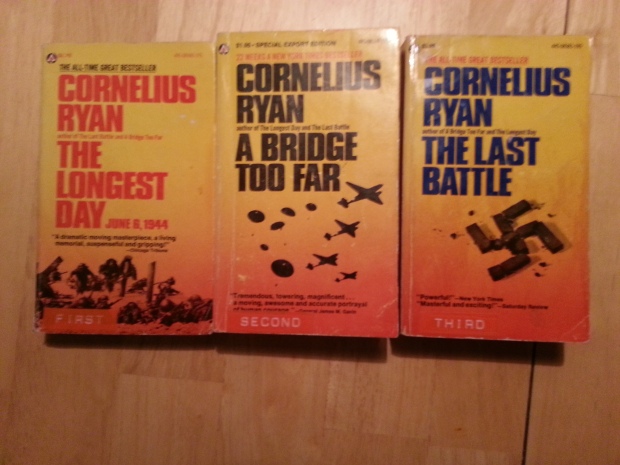
Love the attitude and the hardhat! 😉 Girl had game, yo! Have a good one you!
LikeLiked by 1 person
Our county had a water department that didn’t keep good records of where pipes were buried. I watched Charlie, a man in his eighties, locate our water pipes with divining rods. It was amazing! Great Story!
LikeLiked by 1 person
Thanks Dawn for sharing your story. It’s great to hear similar experiences. Kev
LikeLiked by 1 person